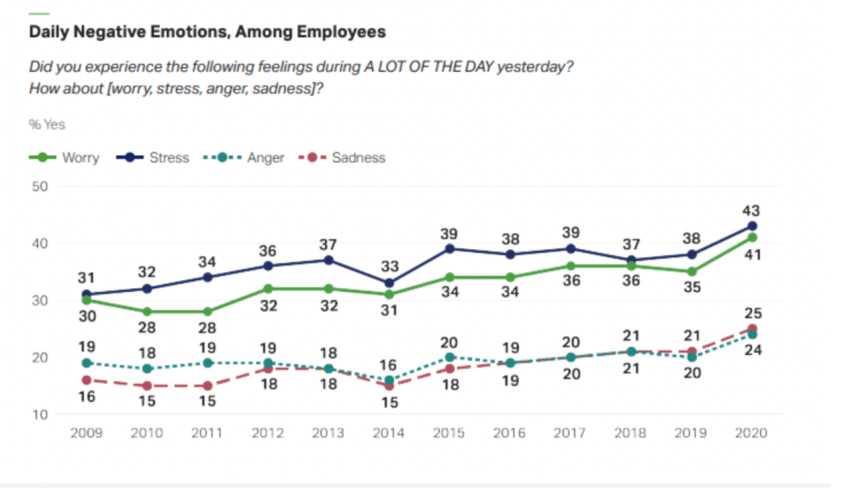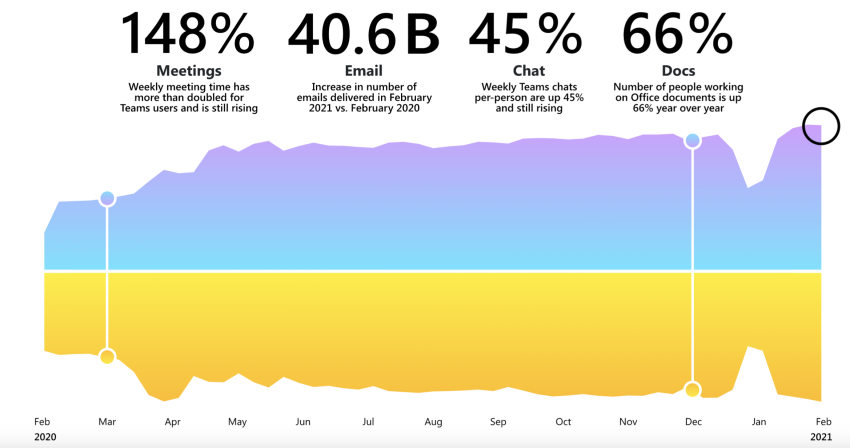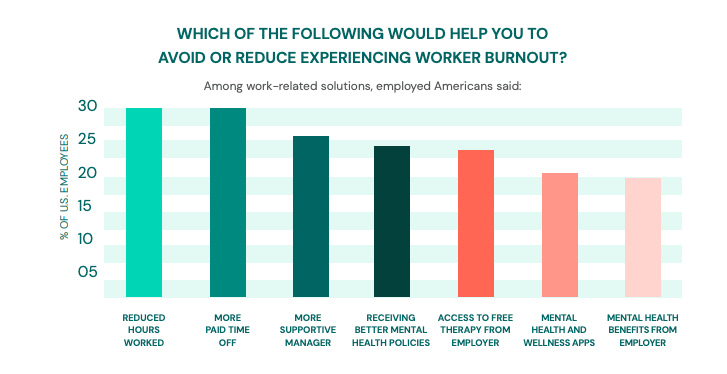As a call center manager, there are times when your team’s performance might not hit the mark.
You’ve hired talented people, yet many of your team members seem disengaged or aren’t reaching their potential. Your employees may be suffering from call center burnout. It’s a problem that’s intensified with companies shifting to remote work during the pandemic.
According to Gallup’s State of the Global Workplace report, not engaged or actively disengaged employees cost US companies approximately $1.9 trillion.
Whether you’re an experienced or newer contact center manager, knowing how to identify agent burnout can help support your team, save costs in lost productivity, and keep employees engaged.
Read on to learn more about how you can navigate call center burnout and reignite your team.
What Is Call Center Burnout?
Call center burnout is defined as physical, emotional, and mental exhaustion from prolonged stress, usually work-related.
For call center agents, this stress builds from demanding performance quotas, difficult customer interactions, long working hours, and little control over high workloads.
Add on isolation and lack of boundaries in remote settings, and burnout creeps over workers, draining their capacity for empathy, decision-making, and effectiveness.
An SQM report found that over 63% of call center agents experience burnout, contributing to a 30-50% annual turnover rate. The cost of replacing and retraining workers is estimated to be 30-50% of an employee’s annual salary.
With nearly 3 million call center agents in the US alone, burnout remains a systemic issue no company can afford to ignore.

Who Experiences Burnout?
Statistics from a Gallup study revealed that a significant 76% of workers experience burnout at some point, with 21% facing it very often.
While burnout can happen in many professions, call center agents are among the hardest hit for reasons that have worsened during the pandemic’s remote shift.
Isolated without camaraderie and lacking separation between work and life, agents juggle endless calls, messages, emails, and other digital tools — all while meeting strict efficiency metrics and facing emotionally draining customer situations.
Call center burnout has become ubiquitous across roles, industries, and demographics.
What Causes Call Center Burnout?
Despite how common burnout is, it’s essential to understand why it happens. Microsoft reported on workplace trends, where Dr. Mary Donohue, a social scientist, concluded the following:

“The exhaustion we’re feeling can be blamed on the speed and urgency of virtual work. In-person conversations give our brains a chance to assess things like tone, social cues, and body language to make meaning. But technology can create digital static: ‘the gap between what you try to communicate online and what the person receiving the message understands.”
Dr. Mary Donohue
Looking at call center work, this “digital static” leads to higher rates of burnout in the profession. Contact center staff must be available for customers more than ever.
A company’s contact center software adds to the stress by rotating between several tools and data sources. This inefficiency contributes to a poor work-life balance and high anxiety, overworking, and exhaustion.
Here are some common causes of call center burnout:
1. Long hours and overworking
Many call centers have shifted to remote work so employees can work anywhere.
However, remote employees often feel pressure to work longer hours to cater to the always-on needs of today’s multi-channel customer experience. As call volume and hours mount, customer satisfaction scores tend to decrease among overworked employees.
According to Indeed’s 2021 Employee Burnout Report, 38% of remote employees feel pressure from managers to work more hours, while 21% feel pressure from customers. Working longer hours with less downtime is a recipe for employee burnout.
2. Digital overload
Virtual call center employees must adapt to a barrage of new business software and communication tools. Since the pandemic, time spent in meetings has more than doubled, chats per week are up 45%, and after-hours chats have increased 42%.

Despite the higher volume of unstructured meetings and messages, half of employees respond to chats within five minutes. With frantic workdays and enormous expectations placed on remote staff, it’s no wonder burnout levels are rising.
3. High call volumes and rude customers
Frontline call center agents must resolve a wide range of customer issues daily. Immersion in customers’ emotions and struggles can become emotionally exhausting, especially at high call volumes.
While strong customer service skills can turn around most uncooperative customers, hearing angry voices day after day taxes employees.
Leaders should acknowledge the taxing nature of frontline work and support staff appropriately.
4. Strict policies and micromanaging
Extensive schedule tracking, handle time monitoring, and customer service QA make call center employees feel constantly watched. This atmosphere erodes morale and trust in leadership.
Employees perform better when given autonomy over task completion.
5. Repetitive, scripted interactions
Call center work tends to involve having the same conversations and answering the same questions over and over. The lack of variety and creativity can lead to boredom and fatigue.
6. Lack of resources and technology
Smooth telework relies on updated, cloud-based technology. However, the rapid shift to remote work has left many employees without the right tools.
Outdated systems lead to disjointed customer experiences, which frustrates call center staff tasked with bridging the gap.
7. Insufficient support and coaching
Pressure to hit metrics can make call centers competitive or even hostile work environments.
Call center employees need positive feedback and incentives to stay motivated. Remote staff also require intentional team-building to avoid isolation.
When call volumes spike or difficult issues arise, agents need managerial support. Without enough coaching or backup, agents can feel overwhelmed.
Signs of Burnout
With contact centers operating remotely, managers may not realize when frontline staff are struggling. Call center leaders should watch for these warning signs of burnout in agents:
1. Fatigue and work avoidance
Exhaustion and trouble sleeping are key symptoms of burnout. Physically worn-out employees may also experience deteriorating health alongside mental strain.
Burned-out staff are 63% more likely to take sick days according to Gallup. While occasional absences aren’t concerning, patterns of absenteeism merit attention.
Leaders should also note if employees consistently sign on late, leave early, take extra breaks, or skip team events.
2. Hopelessness and irritability
Call center agents experiencing burnout often feel pessimistic, hopeless, or quick to anger. If employees seem more prone to conflict or mood swings, investigate potential stressors.
3. Declining performance
Burnout frequently corresponds with reduced productivity and careless mistakes. While burned-out staff are unlikely to seek help, managers should proactively address performance changes through supportive check-ins.
4. Turnover
Burned-out employees are also six times more likely to quit than satisfied staff. Monitor turnover rates and exit interview feedback for signals of systemic issues.
High attrition damages organization morale and budgets. The remaining team members may feel overburdened training new hires who soon leave. Prioritize cultural improvements to retain talent.
Other red flags include withdrawal from colleagues, cynicism, lack of engagement, and difficulty concentrating. Leaders should check in with any employee exhibiting multiple worrisome behaviors to show support.
How To Prevent & Overcome Call Center Burnout
Recognizing that employees are experiencing burnout is the first step.
Preventing call center burnout is a shared responsibility. By working together, employers and employees can create a healthy and supportive work environment that helps everyone thrive.

“Impromptu encounters at the office help keep leaders honest. With remote work, there are fewer chances to ask employees, ‘Hey, how are you?’ and then pick up on important cues as they respond. But the data is clear: our people are struggling. And we need to find new ways to help them.”
Jared Spataro
⏳Encourage regular breaks
Allowing for short breaks throughout the day is vital for call center employees to mentally reset. Build breaks into the schedule, such as a 10-15 minute break every 2 hours.
Also, have supervisors regularly remind reps to step away to get a snack, stretch their legs, or briefly chat with a coworker. Getting up from the desk, even for a few minutes, can help prevent burnout over long shifts.
In addition, consider offering slightly longer meal breaks, such as 45 minutes instead of 30. This extra time goes a long way in allowing reps to fully recharge their focus and energy before tackling the second half of their shift. Make sure break areas are comfortable with access to food/beverages.
✅ Promote workplace wellness
Consider offering short workplace wellness activities during the workday, such as group stretch breaks or mindfulness sessions.
You can bring in an instructor or have wellness champions lead 5-10-minute sessions right on the call center floor. Getting the team to stand up, move around, and focus on breathing/stretching helps boost energy and engagement.
Also, create spaces near the call center for employees to relax and recharge on breaks.
Designate an outdoor area with seating as a “breathing zone” or convert an empty office into a wellness room with yoga mats, calm lighting, and decor. Having access to quiet spaces to meditate or do light exercise can help greatly in coping with daily stress.
🤝 Foster team building and social connections
Call center work can be isolating, staring at a computer screen all day with minimal interaction.
Promote more social connections between employees through team-building activities, group lunches, employee events committees, and mentor programs.
Carve out time each week for structured opportunities for employees to talk together, collaborate, and build rapport.
Consider redesigning the office layout to facilitate more natural interactions, like creating open lounge areas with comfortable seating. Build in rotating schedules for groups of reps to participate in “no-phone Fridays” where they work together on special projects without being on the phones all day.
Strengthening social bonds between coworkers goes a long way in making the environment more welcoming.
📝 Offer personalized training and development plans
Provide each employee with clearly defined training goals and career development plans, customized to their strengths and interests. Give them agency in determining what skills they want to build next. Arrange for them to cross-train across different departments or shadow leadership roles they aspire towards.
Also, bring in experts to provide specialized training programs around topics like coping with stress, effective communication tactics, time management, and working with difficult customers.
Employees will feel more confident and capable of handling the demands of the job if given access to regular professional development opportunities.
🎊 Recognize and reward employees
Implement structured recognition programs to regularly acknowledge employees who go above and beyond.
Have team leaders identify reps to call out each week in team meetings for their accomplishments and dedication. Establish peer-to-peer programs for employees to nominate one another for monthly rewards.
Consider creative reward options — provide gift cards for coffee shops, movie theaters, restaurants, etc. Or surprise reps by randomly providing breakfast spread or snack baskets.
Find simple yet meaningful ways to show employees their efforts are valued and make a difference. Public praise and nominal rewards boost morale and make the workplace culture more uplifting.
🖥 Empower with technology and choice
Repetitive tasks drain energy. Implement automation tools for routine processes, giving agents more time for complex interactions.
Offer flexible scheduling options so they can adjust to personal needs and maintain control over their workday. This reduces stress and fosters ownership, combating the feeling of being stuck in a monotonous grind.
Shifting to a cloud call center platform enhances the reliability of a virtual workforce. With calls and chats handled by agents, customers can avoid long wait times and get the help they need.
Contact center software allows managers to track call volume and agent performance easily.

Automated customer service can lighten the workload and enhance the customer experience. As a result, employees can give each customer a higher level of attention and care. In addition, agents have more enjoyable customer interactions instead of being overloaded with tasks.
🔎 Survey regularly and make improvements
Check in often with employees to assess their satisfaction levels and pinpoint areas for workplace improvements.
Conduct regular surveys, pulse checks, and focus groups to understand the challenges employees face. Solicit their honest input on what types of additional support or resources would prevent burnout.
Then, follow through on making enhancements based on their feedback – update technologies and equipment, amend schedules, and improve training.
Closing the loop by keeping employees informed on changes being implemented builds trust and shows that leadership is responsive to employee wellbeing. This visibility into constant improvements reassures staff that preventing burnout is an ongoing priority.
How To Support Burnt-Out Agents
When talented, hardworking agents become emotionally exhausted, disengaged, and feel they lack support, it hurts morale, productivity, and retention. As managers and leaders, you need to aid those struggling with burnout and restore their well-being.

Implementing small but impactful policy changes and support resources can give agents the respite, skills, and resilience to bounce back.
- Encourage time off. Allowing agents to take vacation days or mental health days can give them much-needed rest and relief from job stress. Make sure time off requests aren’t discouraged or denied unless necessary.
- Offer workload flexibilities. See if temporary workload reductions or schedule changes could be implemented. For example, switching an agent to part-time or allowing a less demanding position for a period can remove pressure. Make it clear these options won’t negatively impact their standing.
- Provide coaching/mentoring resources. Assign struggling agents a dedicated, supportive leadership contact to check in, troubleshoot issues, and provide coaching. Also, consider a peer mentoring program so agents can get advice and encouragement from colleagues who have dealt with and overcome burnout.
- Promote stress relief activities. Boost morale and reduce anxiety by organizing office activities like bringing in a therapy dog for employees to play with on break, setting up a “quiet room” for relaxation techniques, or establishing walking clubs before/after shifts. Show that stress relief is valued and priorities self-care.
Address Burnout Before It’s Too Late
Burnout happens in every industry, but the relentless emotional strain of customer-facing roles makes it especially prevalent among call center staff. That’s why managers must make addressing burnout a priority — the human, financial, and operational costs are too high to ignore.
Mitigating the conditions that lead to burnout retains top talent, bolsters morale, enhances employee engagement, saving thousands in recruiting and retraining new staff.
People on both sides of the phone contend with intense stress — agents must placate angry customers, then face stats-focused managers pressuring them to do even more. This pressure-cooker environment risks compassion fatigue.
However, engaged, energized employees provide better, more empathetic customer service. In turn, happier customers promote positive word-of-mouth and loyalty.
The solutions lie in communication, compassion, and a culture that puts people first. Though call volume targets and efficiency matter, leaders must balance business needs with reasonable workloads, appropriate scheduling, and praise for staff who go above and beyond.
Make agent sanity, satisfaction, and growth the priority — both moral and fiscal incentives demand it. Tackle burnout now, or risk an empty, unmotivated workforce.

















 Productivity
Productivity 











